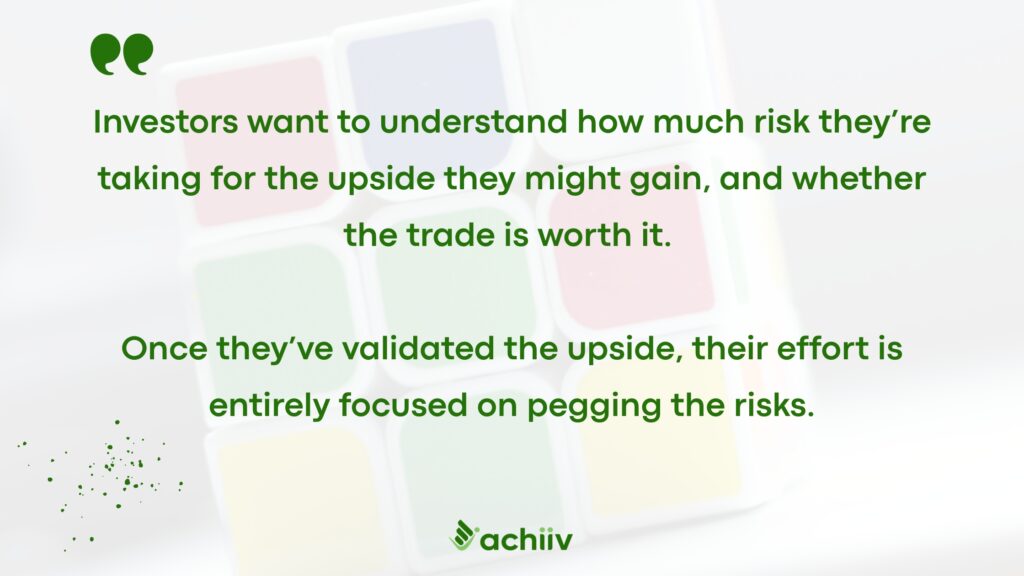I recently met a sharp B2B founder who was describing his challenges with setting up his data room. As he talked, I realized one thing many founders miss: data room creation and due diligence prep are all parts of a single process of preparing, pressure-testing and proving the hidden foundations of your investment story.
The reason many founders struggle with fundraising prep is that they don’t realize why investors do what they do. Once you understand the “why” behind their actions, you’ll do a much better job starting with the pitch, through investor Q&A, all the way to having a solid data room and getting through due diligence.
Think about what your investor faces when you arrive at their doorstep with a nice, shiny pitch. They know you’ve gone out of your way to tell a polished story of sky-high opportunity. They also know from past history that the most likely outcome is they’ll lose money, or maybe breakeven, with a small shot at making a lot of money.
They want to understand how much risk they’re taking for the upside they might gain, and whether the trade is worth it. Once they have validated the upside, all their effort is then focused on correctly pegging the downside risks.
All the confusing, opaque activities you go through in fundraising, from investors asking you “random” questions, to the document and data requests, and the excruciating due diligence process, are all aimed at one thing: helping investors construct a careful risk canvas to capture your startup’s risks.
The Four Views to Frame Your Raise Prep
The most intuitive way to prepare for a smooth raise is to organize your efforts around the areas of risk that investors care about. Your work becomes easier, more meaningful, and frankly, even fun because you now have agency and ownership in what you’re doing – and that’s a huge green flag for investors!
Investors focus on risks in four broad areas:
Product, Technology and IP Risk
Your startup exists because you’re bringing something new and innovative into the world. Investors want to test if the science or technology behind it is credible, novel and protectable via patents or copyrights. They also want to know if it works “as advertised” and more importantly, if the “dog will eat the dog food”, i.e., customers buy and use the product with urgency and enthusiasm. E.g., your new battery technology is really 50% more energy efficient, and has a strong patent.
Commercial Viability Risk
What investors are testing for here is: is there a large, accessible, and urgent market for this new product? For STEM and deep tech startups especially, a revolutionary new product does very little to ensure a big market. They want to know how it will make money, who specifically will buy this, why this purchase is urgent or inevitable for them, and how you’ll get the product to them in a scalable and affordable way, e.g., multiple steel plants showing high interest in your decarbonization technology.

Funding & Execution Risk
One of the biggest risks early stage investors face is startups that don’t have a clear execution roadmap or a high level idea of how much money they’ll need in total. When you don’t know where you’re going, it’s easy to blow up all your money getting there, i.e., nowhere – and that’s true whether you’re raising $500,000 or $5 million. They want to understand how thoughtful and thorough you’ve been in planning your road to viable commercialization.
Legal, Deal & Investment Risk
None of the above matter much if they aren’t wrapped up in a squeaky clean legal and deal package that has no “hair” on it (the term finance types use for any problematic aspects of the deal). In other words, investors want you to show that your startup is structurally sound, clean, and investable, e.g., your cap table is clean, you don’t have unusual founder agreements.
A Clean, Streamlined Approach to Prep
The big aha here is that you don’t need a disjointed, reactive and duplicative process to prepare for investor Q&A, data room and due diligence. You can combine these three steps into a single, streamlined process provided you build it – and your strategy – around this investor logic.
In other words, you prepare so that the investment memo for your startup almost writes itself. In fact, you can help the process along by writing one yourself – after you’ve done this prep.
Step 1: Articulate The Story
For each risk category, articulate your story for the key questions, and why your answers are credible. For product, technology, and IP strategy, for example, try these:
- What does the technology do, in simple terms?
- What is the development stage (e.g. TRL stage)?
- How have you validated performance?
- How do you protect your intellectual property?
Having this story in one place prepares you well for answering investor questions credibly. Bonus: You can update this list if new areas come up repeatedly in investor grilling that you hadn’t covered before.
Step 2: Collect the Data & Documents
With your strong list of the most important claims investors will double check, identify and gather the data and documents you’ll need as “receipts” to back up your claims. Also ask what could go wrong with each, and what you might show to address that risk.
For example, to evidence your product, technology and IP claims, you may focus on:
- Lab results, prototypes, third-party validation, and reproducible data.
- Current TRL (technology readiness level), key unknowns, and your plan to address them.
- IP filings, license agreements, FTO (freedom to operate) analyses, well-supported patent strategy
- Comparison of your technology to alternatives and proof of why this is better and viable.
Tag specific data or documents that cannot be shared without an NDA or that have other restrictions. Going through your claims across all four categories provides an instant, convenient snapshot of what you have and what you don’t – your to-do list for the data room and due diligence prep, in fact!
Step 3: Organize Your Data Room Layers
This is where everything comes together to make your life, and your investors’ lives easier.
Organize your data room’s structure to align with these key risk buckets, for example:
- Executive summary & overview
- Product, technology & IP
- Technology,
- IP
- Product Development
- Market & commercialization
- Funding & execution
- Business model & financials
- Grants, non-dilutive funding, and contracts
- Team & org structure
- Legal & Deal
- Corporate documents
- Cap table
- Diligence FAQs / Risk Factors
Use any structure that works provided it’s logical and coherent.

Now you get strategic and intentional. For each folder, stage-gate data according to when and to whom you’ll make it available. Specifically, set up separate spaces and access controls for:
- First look data you’ll show to all interested prospects as the first step
- For example: Pitch deck, one-pager, overview of tech and business model, team bios, high-level deal terms and use of funds, milestone summary
- Detailed data for regular due diligence including those requiring NDA’s
- For example: Full tech validation and test data, LOIs, discovery reports, financial model and full cap table, agreements and licenses
- Custom deep dives you’ll share with selective audiences, but not with all investors
- For example: deep dive tech data, regulatory strategy for domain specific investors, partner terms and roadmap integrations for strategics, growth cases, alternate scenarios for financial investors
- Hidden founder prep data: a private subfolder in each area, only for your reference
- For example: Backup data, analysis, working versions of sensitive materials, notes or framing to answer tough questions in real time
Making It Happen
Yes, this is harder than dumping all your data into some template format and hoping you won’t have to deal with it anymore. But the upfront investment will pay off richly as you transition to later stages of funding and maturity, and make it that much easier to execute a smooth and impactful exit.
Here’s how to make it work:
- Conduct a risk awareness and readiness audit for each of the four areas: What are your answers? How well-supported are your claims? How credible is your data?
- Create the list of data and documents you need to prove each claim
- Define a starting structure for your data room and craft the end game for the data you need to evidence each area of risk
- Identify the stage-gated data you’ll need, when and for whom, and populate your data room with appropriate access controls.
You’ll now be walking in the shoes of your potential investors. To prove it for yourself, write your investment memo after you’ve gone through this process and see for yourself how much sharper your story now looks!
A special thanks to my esteemed colleague and mentor Ron Weissman, Outgoing Chair of the Angel Capital Association, for his thoughtful comments and insights.







